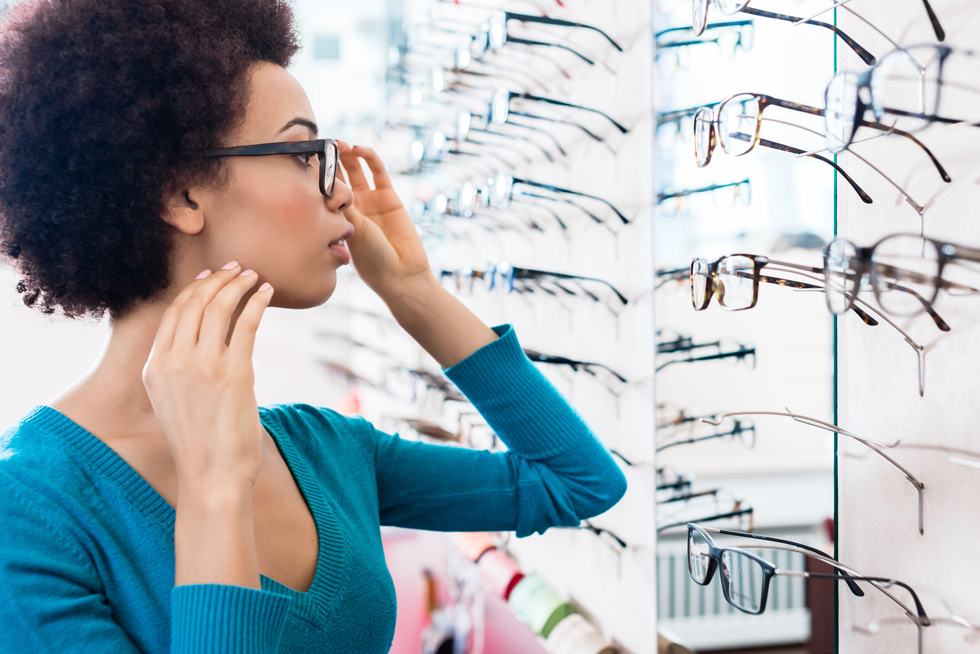
When we say ‘reading glasses’, you might automatically imagine people wearing glasses to read their favourite book. However, prescription reading glasses can be used for all sorts of daily activities, such as computer work, viewing your vehicle’s dashboard, reviewing a menu at arm’s reach, or texting without your phone touching your nose.
By investing in the correct reading glasses, you can enjoy a more comfortable viewing experience when going about your day-to-day life. They also provide multiple health benefits, such as reduced headaches, eye strain, tiredness and blue light damage from staring at screens too closely.
How do you know which reading glasses strength you need?
Have you noticed you’ve started to move a magazine closer to your face as you read? Perhaps the font on your email is starting to blur, and you’re squinting as you try to focus. These are signs you may require prescription reading glasses. However, the strength you need for your reading lenses will vary from person to person.
The quickest and most accurate way to determine the strength of your reading glasses is by booking an appointment with your optician. This is because you may need different lens strengths for each eye. Your optician will be able to prescribe individual lenses to create a balanced view when wearing your favourite reading frames.

Non-Prescription vs Prescription Reading glasses: What’s the difference?
If you notice a change in your eyesight, we always recommend you visit your opticians. However, when it comes to reading glasses, over-the-counter or non-prescription reading glasses are popular options.
Non-prescription reading glasses magnify your line of vision, making the text you’re reading larger and sharper to see. They can vary in strength but only by small margins, and they’ll have the same strength within each lens. Non-prescription reading frames are also a one-size-fits-all, so they might not be a comfortable fit for long periods.
The pros of non-prescription reading glasses:
- Easy to pick up from high street stores
- Available for most reading lens strengths
- A cost-effective option
- Convenient to replace
- The cons of non-prescription reading glasses:
- They’re not bespoke to your visual needs
- Limited choice of frames
- No additional lens features
- They’re not shaped to fit your face
Prescription reading glasses are customised to your visual requirements. This could include different strengths within each lens or even bifocal and varifocal lenses for wearers requiring reading and distance vision lenses. Furthermore, prescription reading frames are adjusted to fit comfortably to your face shape.
The pros of prescription reading glasses:
- Reading lenses are bespoke to your requirements
- A wider range of reading frames
- Reading prescriptions can be fitted into any frame
- They fit comfortably on your face
- An investment in your eye health
- You can add extra lens coatings with Lensology
The cons of prescription reading glasses:
- It can be an expensive option
- You’ll need an opticians appointment
- They may take longer to buy and repair
Why is it so important to have the right reading glasses strength?
Reading lenses are designed to aid your lifestyle. The right reading glasses strength means you can pick up and comfortably read your favourite books or magazines. It means you don’t have to expand the size of your screen to read messages or emails, but most importantly, having the correct reading glasses strength means you’re supporting your eye health. With reading glasses, you minimise eye strain and squinting, reducing headaches, tiredness and wrinkles!
What are the highest and lowest reading glasses strengths available?
The average strength of reading glasses is between +0.75 and +2.50 diopters, with diopters being the unit lens strength is measured in and indicated by the + symbol. This is the measurement that’ll appear on your optical prescription and determines the power of your reading glasses.
Reading lens strengths can go as low as +0.25 and as high as +4.00 diopters, but these higher requests often have to be custom-made. Most strengths are available in non-prescription reading glasses, but for tailored prescription lenses and a comfortable fit, head to your opticians. Once you have your prescription, Lensology can reglaze and fit your personal reading lens requirement into your favourite glasses frames.
Our eyesight will naturally change as we age, with our nearsightedness struggling to focus on items close up. This is when it might be worthwhile investing in reading glasses to ease any discomfort, eye strain or headaches.
What is the best way to find the right reading glasses?
Once you’ve established which strength you require from your reading glasses, the rest comes down to personal preference. Opticians and high street stores will have a selective range of reading glasses, which might not be to your liking. However, if you spot your dream pair of specs or designer frames, we can transform them into your perfect reading glasses.
We can even take them one step further by not only reglazing your existing frames with a bespoke reading lens but also by adding additional features such as polarised lenses, coloured tints, or blue light protection.







